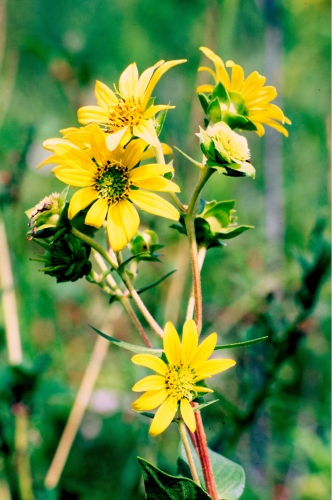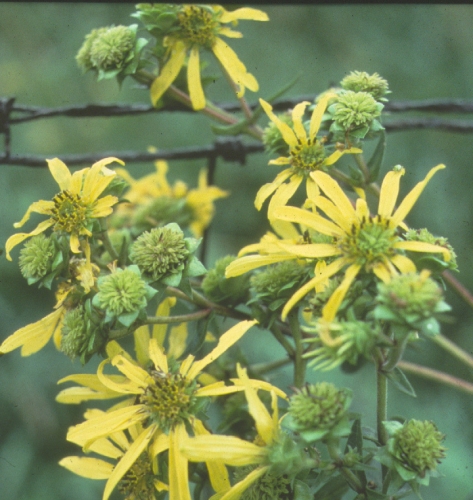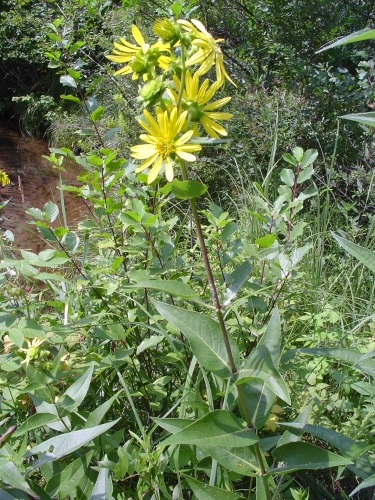Plants and Animals
Silphium integrifolium Rosinweed
Key Characteristics
Stout forb (1.5 m) of moist to dry-mesic prairies and fens; leaves opposite, sessile, and ovate, with a very rough upper surface; inflorescence compact with several large sunflower-like heads (4-8 cm across).
Status and Rank
US Status: No Status/Not Listed
State Status: T - Threatened (legally protected)
Global Rank: G5 - Secure
State Rank: S2 - Imperiled
Occurrences
| County | Number of Occurrences | Year Last Observed |
|---|---|---|
| Berrien | 12 | 2016 |
| Cass | 14 | 2016 |
| Kalamazoo | 14 | 2019 |
| St. Joseph | 2 | 1986 |
| Van Buren | 3 | 2009 |
Information is summarized from MNFI's database of rare species and community occurrences. Data may not reflect true distribution since much of the state has not been thoroughly surveyed.
Habitat
Rosinweed occurs in prairie remnants along roads and railroad tracks or in cemeteries, in wet-mesic prairies and fens on peaty mucks and loams, and on dry-mesic to mesic loams and sandy loams.
Natural Community Types
- Bur oak plains
- Dry-mesic prairie
- Hillside prairie
- Mesic prairie
- Oak openings
- Prairie fen
- Southern wet meadow
- Wet prairie
- Wet-mesic prairie
- Wet-mesic sand prairie
For each species, lists of natural communities were derived from review of the nearly 6,500 element occurrences in the MNFI database, in addition to herbarium label data for some taxa. In most cases, at least one specimen record exists for each listed natural community. For certain taxa, especially poorly collected or extirpated species of prairie and savanna habitats, natural community lists were derived from inferences from collection sites and habitat preferences in immediately adjacent states (particularly Indiana and Illinois). Natural communities are not listed for those species documented only from altered or ruderal habitats in Michigan, especially for taxa that occur in a variety of habitats outside of the state.
Natural communities are not listed in order of frequency of occurrence, but are rather derived from the full set of natural communities, organized by Ecological Group. In many cases, the general habitat descriptions should provide greater clarity and direction to the surveyor. In future versions of the Rare Species Explorer, we hope to incorporate natural community fidelity ranks for each taxon.
Associated Plants
Big bluestem, little bluestem, cordgrass, prairie coreopsis, wild geranium, pale-leaved sunflower, false boneset, smooth sumac, rosin weed, yellow-pimpernel, hoary vervain, prairie violet, golden alexanders, spiderwort, western sunflower, stiff goldenrod, blazing-star, tall coreopsis, sedges, marsh fern, Culver’s root, spotted joe-pye weed, prairie dock, and meadow-rue. It can also persist on severely degraded prairie sites, growing with such weeds as yarrow, pasture thistle, and daisy fleabane.
Management Recommendations
To maintain this species, protect the habitat and hydrological and natural disturbance regimes. This species likely requires natural disturbances associated with prairie habitat such as fire or brush removal to prevent woody plant succession. Significant increases in vegetative and reproductive vigor have been observed following early spring and fall burns. Much of this habitat type has been lost or severely degraded. Many prairie remnants are vulnerable to common right-of-way maintenance activities such as mowing, herbiciding, and bulldozing.
Survey Methods
Random meander search covers areas that appear likely to have rare taxa, based on habitat and the judgment of the investigator.
-
Meander search
-
Survey Period: From first week of July to fourth week of September
-
References
Survey References
- Elzinga, C.L., D.W. Salzer, and J.W. Willoughby. 1998. Measuring and Monitoring Plant Populations. The Nature Conservancy and Bureau of Land Management, Denver. BLM Technical Reference 1730-1. 477pp.
- Goff, G.F., G.A. Dawson, and J.J. Rochow. 1982. Site examination for Threatened and Endangered plant species. Environmental Management 6(4): 307-316
- Nelson, J.R. 1984. Rare Plant Field Survey Guidelines. In: J.P. Smith and R. York. Inventory of rare and endangered vascular plants of California. 3rd Ed. California Native Plant Society, Berkeley. 174pp.
- Nelson, J.R. 1986. Rare Plant Surveys: Techniques For Impact Assessment. Natural Areas Journal 5(3):18-30.
- Nelson, J.R. 1987. Rare Plant Surveys: Techniques for Impact Assessment. In: Conservation and management of rare and endangered plants. Ed. T.S. Elias. California Native Plant Society, Sacramento. 8pp.
Technical References
- Antonio, T.M. and S. Masi. 2001.The Sunflower Family in the Upper Midwest. A Photographic Guide to the Asteraceae in Illinois, Indianan, Iowa, Michigan, Minnesota and Wisconsin. Indiana Academy of Science, Indianapolis. 421pp.
- Deam, C. C. 1940. Flora of Indiana. Department of Conservation, Indianapolis. 1236pp.
- Flora of North America Editorial Committee. 2006. Flora of North America, North of Mexico. Volume 21: Magnoliophyta: Asteridae (in part): Asteraceae, part 3. Oxford University Press, New York. 616pp.
- Gleason, H. A., and A. Cronquist. 1991. Manual of Vascular Plants of Northeastern United States and Adjacent Canada. Second edition. The New York Botanical Garden, Bronx. 910pp.
- Gray, A. 1950. Gray's Manual of Botany; eighth ed. Van Nostrand Reinghold, New York. 1632pp.
- Holmgren, N.H. 1998. Illustrated Companion to Gleason and Cronquist's Manual. Illustrations of the vascular plants of Northeastern United States and adjacent Canada. New York Botanical Garden, Bronx. 937pp.
- Mohlenbrock, R.H. 1986. Guide to the Vascular Flora of Illinois. Southern Illinois University Press, Carbondale. 507pp.
- Swink, F. and G. Wilhelm. 1994. Plants of the Chicago Region, 4th ed. Indiana Academy of Science, Indianapolis. 921pp.
- Voss, E.G. 1996. Michigan Flora. Part III. Dicots (Pyrolaceae-Compositae). Bulletin of the Cranbrook Institute of Science and University of Michigan Herbarium. 622pp.




